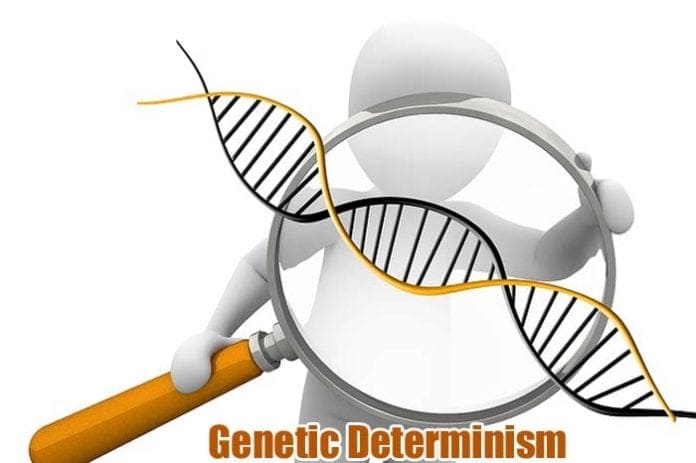Genetic Determinism : The human body – its functions and features are determined by the genetic content it carries. Every individual possesses a set of genetic factors that ascribe traits to them.
An interplay between the environment and complex gene expression determines factors such as our hair color, eye color, height, susceptibility to specific disorders
However, an emerging idea in the field of genetics genetic determinism . Also known as Biological Determinism , this concept entertains the belief that human behavior
Having dimples vs not having dimples is driven by the genetic characteristics. It conveys the ideology that mental and physical characteristics of a human being are decided at conception by genetic factors inherited by the offspring of the parent.
Although it is known today, that an individual’s personality and traits are the result of a complex interplay between the environment and gene expression, as well as epigenetics , some still regard the deterministic model to be true.
Definition of Genetic Determinism Biological determinism or genetic determinism is the notion that human behavior is dominated by an individual’s genes or some element of their physiology
History of Genetic Determinism The theory of genetic determinism or biological determinism was prevalent in the late 19th and early 20th centuries. These theories were based on unclear assumptions and were often controversial. Refer to the full history of genetics
The tools and techniques of molecular biology They studied the cranial capacity, the facial angle and other such factors comparing them to human behavioral and intellectual capacities. Any negative trait was viewed in the light of genetic determinism and was deemed to be an undesirable trait that arises due to specific defective anatomical features defined by one’s genetic component. With the discovery of genes and DNA, these negative traits were thought to arise from defective genes, resulting from a fault in the DNA sequence, in the perspective of genetic determinism. Although researchers agree that genetic defects do lead to defects in physical appearance and disorders, the notion that all of these are inherited is generally false.
August Weismann’s Proposals August Weismann (Source: Wikimedia) Genetic determinism aimed to relate undesirable traits such as criminal behavior, low IQ, feeble-mindedness, and physical disorders and disabilities to genes inherited.
In the year 1892, the theory of germplasm, proposed by August Weismann , was the first theory that would be one of the building blocks for the origin of genetic determinism. Weismann proposed that all organisms have two types of cells – somatic cells germplasm for inheritable material that was contained inside the germ cells. Weismann argued that the environment or outside factors do not have any influence over the germplasm or traits acquired by an individual and that it is strictly inherited in a one-way transfer from parent to offspring. In the coming years, this ideology would give rise to genetic determinism.
Development of Eugenics Francis Galton (Source: Wikimedia) The belief that undesirable traits were inherited led to the development of eugenics.
An ideology that sought out to prevent individuals with these undesirable traits from breeding by sterilizing them. It was thought that underlying physical and mental defects were the cause of human behavioral problems such as alcoholism, criminality and many examples. The Eugenics movement, started in the 1920s, by Francis Galton , and was aimed at reducing the incidence of undesirable traits by preventing defective people from breeding.
Unothodox Experiments in Genetic Determinism Alfred Binet (Source: Wikimedia) Sterilization laws were introduced in the US and Germany which made persons with mental and physical disabilities candidates of compulsory sterilization apart from inmates, prisoners, and mental asylum inhabitants.
A step too far under the banner of genetic determinism was perhaps exhibited by two scientists – Samuel Morton and Paul Broca , who attempted to measure the cranial capacity of the human skull and link it to skin color, to show white superiority. Two other scientists Alfred Binet and H. Goddard studied human IQ and attempted to show its heritability to strengthen the white superiority theory further. These studies were made so stringent that people were scored and ranked into different classes according to a quantitative measure. A person with an IQ less than average was considered genetically disabled.
Concepts of Genetic Determinism
Fundamentally, genetic determinism entails the view that only genes or genotypes are responsible for characteristics or traits called phenotypes .
It treats genes as the most critical factor of inheritability of traits, and that causation is always a must if a particular gene for a particular trait is inherited. However, in truth, the presence of a defective or mutated gene, in many cases, merely increases the probability of acquiring a certain disease and mostly requires interplay with environmental factors. For example, the presence of the mutation In contrast, some diseases like sickle cell disease (SCD) are caused by a mutation in the gene that codes for hemoglobin . A defect in this gene, if carried by an individual on both chromosomes
Types of Genetic Determinism
Genetic determinism can be classified into three types:
Strong Genetic Determinism : This type of genetic determinism holds the view that if an individual has gene A, it will always cause Trait B, which means that the probability of developing trait B is higher than or equal to 95%, in the presence of gene A.Moderate Genetic Determinism : This type of genetic determinism holds the view that if an individual has gene A, it can more often than not cause trait B, which means the probability of developing trait B is greater than 50% in the presence of gene A.Weak Genetic Determinism : This type of determinism holds the view that if an individual has gene A, it can sometimes lead to the development of trait B, which means the probability of developing trait B is less than 50%, in the presence of gene A.
Occurences of Genetic Determinism Among the three types of genetic determinism described above, strong determinism is rarely found.
Firstly, this is because in almost all cases, the role of the environment in causation is indispensable. For example, an individual possessing the gene that predisposes him or her to alcohol, will not develop alcoholism if they do not drink alcohol at all. Secondly, a reason for the invalidity of the ideology of genetic determinism is that a single gene is not always implicated in a disease. Most diseases are caused by a complex interplay of several different genes and epigenetic factors along with a contribution from environmental factors. Finally, the developmental process of an individual from conception can influence the way genes are expressed. So, two genomes which are identical can differ significantly phenotypically if their developmental factors are different.
It is important to understand that a multitude of different factors governs disease causation. Today, with advances in genomics and molecular biology, we can comprehend the many connections between our genomes and the environment.
However, the idea of genetic determinism still lives widespread today, and many people believe that possessing the genes for diseases, without lifestyle or diet constraints, can lead to a particular disease by itself.
Many researchers believe that once we can find the kill switch for genes like obesity, cancer, and alcoholism, these diseases will automatically be eliminated. However, it is not that simple.
Cite This Page
“Biological determinism | Britannica.com” . Accessed May 04, 2018. https://www.britannica.com/topic/biological-determinism.“Evolutionary Psychology–Genetic Determinism” . Accessed May 04, 2018. http://www.personalityresearch.org/evolutionary/determinism.html.“GENETIC DETERMINISM” . Accessed May 04, 2018. http://www.indiana.edu/~p1013447/dictionary/gen_determinism.htm.“The social and economic origins of genetic determinism: a case history of the American Eugenics Movement, 1900-1940 and its lessons for today. – PubMed – NCBI” . Accessed May 04, 2018. Link .“Genetic modification and genetic determinism” . Accessed May 04, 2018. Link .“Biological determinism facts, information, pictures | Encyclopedia.com articles about Biological determinism” . Accessed May 04, 2018. Link .























